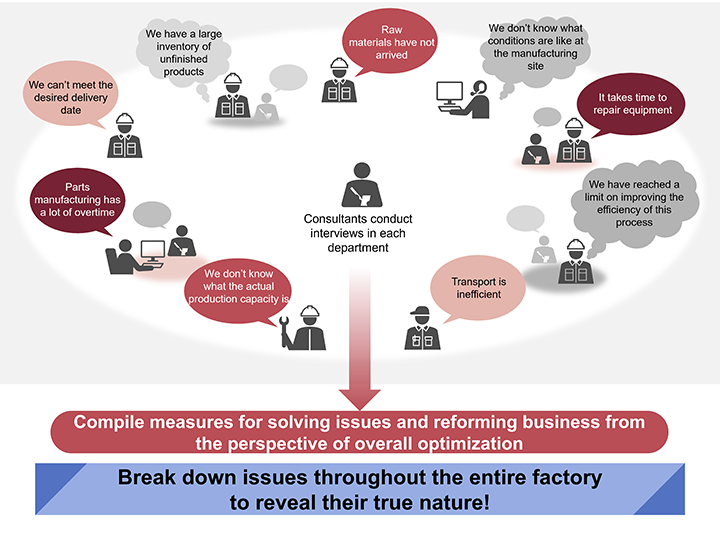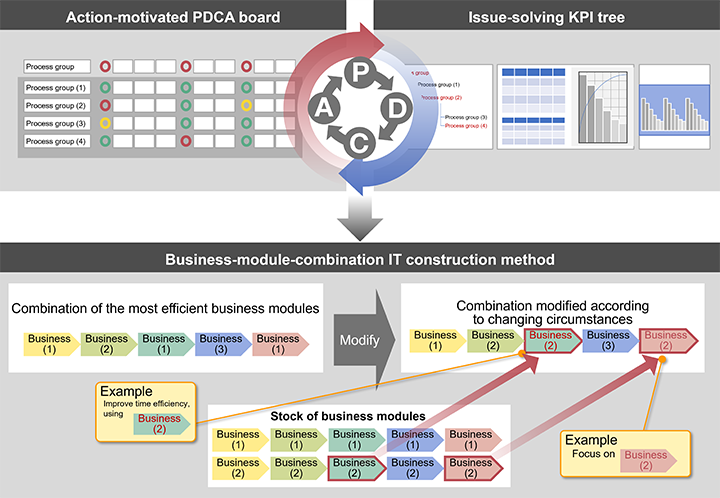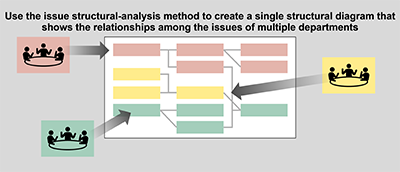Featured customer case
Lumada customer case code: UC-01765S
Improving Effectiveness and Awareness from the Customer’s Perspective
2022-03-31

Manufacturing sites are required to further improve their operations and achieve results, such as improving production efficiency and reducing costs. In this article, we will introduce a customer case for achieving total factory optimization with business consultation for structuring complex and wide-ranging issues and presenting effective measures, as well as an IT construction method that combines business modules.
Understand the current situation and essential issues of the factory from an organizational perspective of total optimization and objective analysis. Agree on the customer’s goals and realistic solutions. Guide both management and manufacturing sites toward the goals by gradually achieving effects in a feasible manner, gaining the understanding of manufacturing sites, and then expanding the approach throughout the entire factory.
Co-creation with Lumada! Visualizing Business Operations Through Business Consultation
As we strive to improve the efficiency of business operations on a daily basis, there is a need for reforms for competitive manufacturing and further improvement to enable speedy management decisions.
We have implemented a variety of innovations at factories and made efforts to maximize the efficiency of each process, which has led to improvements.
While high-mix low-volume production allows factories to respond to the diversifying needs of their customers, it also increases the number of setup changes that are required when changing the products to be manufactured. Because the production line is shut down each time this happens, they keep an inventory of finished products that can be continually provided to later processes, to fill any gaps due to differences in setup. In addition, they created a system that prepares for unexpected changes in required volume between processes to ensure that the inventory of finished products does not run out, thereby achieving non-stop manufacturing.
In recent years, the entry of emerging countries and other industries into the market has made it imperative for manufacturers to reform their manufacturing operations to become more efficient and competitive, and management is demanding that factories improve their operations to further shorten lead times and reduce costs. Inventory that has been reserved for non-stop manufacturing will also be subject to reduction. However, departments and processes that have been making a variety of improvements to maximize efficiency are now finding that they have run out of options.

In each department and process, there are limits to how much lead time can be shortened, how far inventory can be reduced, and how deeply costs can be cut. In order to further improve production efficiency after making all the improvements that can be made, it is effective to implement operational reforms that review roles and processes from the perspective of optimizing the entire factory (a perspective of overall optimization), rather than making separate improvements for each department or process.
Through business consultation, Hitachi engages in frank discussions with management and each department at the manufacturing site to accurately analyze the current state of the factory. We clarify issues that require feasible solutions, and come up with measures that are acceptable to both management and the workers on site.
Furthermore, we use technologies patented in Japan and the US to visualize daily manufacturing operations and the status of medium-term initiatives, and to build a business management system that is necessary for implementing easier reforms. Through these efforts, we continue to support our customers so that everyone involved in factory management and operation can work autonomously to make improvements for overall optimization.
Our business management system consists of a combination of business modules for various functions. Rather than customize an existing system, we select the modules that are necessary for solving an issue, assemble them with the minimum required content, and then verify whether they are effective and technically feasible. This allows the customer to invest in and build a system that is best suited to their situation while checking its effectiveness.
In addition, the system can be changed by modifying or switching the functions of the business modules. Because the system can be flexibly adapted to meet the needs of management and manufacturing sites at any given time, we can easily respond to changes in the customer’s business processes or manufacturing lines, including expansion to other factories.
Linking management and manufacturing sites to create factories where
conditions are transparent and improvements can be monitored
By visualizing and making comprehensive use of the information from manufacturing sites, it is possible to quickly implement the PDCA cycle throughout the entire factory and share KPIs that are hierarchically linked from management to the manufacturing sites.
Solution for the Visualization of Factory Operations (hereafter “the solution”) is a solution that helps customers solve their issues and reform their business operations through business consultation for overall optimization and IT services for sustainable improvement based on a customer-focused approach.
During business consultation for overall optimization, our experienced consultants conduct interviews in each department of a factory. We use the issue structural-analysis method to break down the wide range of complex issues throughout the entire factory from the perspective of overall optimization, which allows the customer to see the true nature of issues that have gone unnoticed.
Because many issues require the cooperation of multiple departments to solve, it is important to coordinate different opinions and build consensus. Hitachi engages in earnest and sincere dialogue, and sets forth realistic solutions that are acceptable to the customer. We then present concrete measures and action plans that provide value to the customer, and estimate their quantitative effects.

With our IT services for sustainable improvement based on a customer-focused approach, we use the action-motivated PDCA board* and issue-solving KPI tree* to promote system construction in line with specific measures. The action-motivated PDCA board brings attention to the status of abnormalities, and encourages related parties to take action to implement the appropriate countermeasures. The issue-solving KPI tree allows management and the business departments at manufacturing sites to share the level of achievement of KPIs. These technologies create a system that allows the PDCA cycle to run throughout the entire factory, both immediately and over a medium-term span.
In addition, we use the business-module-combination IT construction method*, whereby business operations are modularized into functional units and combined according to the customer’s requirements, to achieve the results of business consultation for overall optimization based on the customer-focused approach.


When multiple departments are involved, business reforms become more difficult due to varying interests.
Using the solution issue structural-analysis method allows thousands of issues from multiple departments to be represented in a single structural diagram, from which we can unravel the essential cause-and-effect relationship between management propositions and the issues that business departments face.
This structural diagram that visualizes issues can be used to promote smooth consensus building between management and the workers at manufacturing sites, and also leads to a change in awareness.
In July 2020, we started a PoC (proof of concept) for the solution in the gear machining process at Yamaha Motor’s Hamakita factory.
This factory, which has been thoroughly improving its daily efficiency through its unique theoretical-value-based production methodology, has decided to further shorten lead time, reduce inventory, and cut costs to achieve the following objectives:
The target area covers multiple departments, including management, manufacturing (all worksites throughout the factory), operation engineering, quality control, maintenance, and production technology. The following effects were achieved by identifying issues from the perspective of overall optimization and implementing solutions that everyone could understand:
In addition, we were able to confirm that the solution was effective in accelerating the shift to multi-skilled workers and improving the speed and accuracy of resource management at manufacturing sites. Another benefit of introducing of the solution was that we were able to raise awareness and create manufacturing sites where workers were confident and highly motivated.
In the future, we will use the experience gained from our PoC with Yamaha Motor to develop the solution as a digital transformation service that allows effective and sustainable improvements to take root at manufacturing sites, for our customers in the assembly, machining, and other manufacturing industries. In addition to the manufacturing domain, we will also expand the solution to all other areas of the value chain, to create a system of connected social innovation that allows co-creation among many industries and business areas.
For more details about this solution, visit the following page.
Understand the current situation and essential issues of the factory from an organizational perspective of total optimization and objective analysis. Agree on the customer’s goals and realistic solutions. Guide both management and manufacturing sites toward the goals by gradually achieving effects in a feasible manner, gaining the understanding of manufacturing sites, and then expanding the approach throughout the entire factory.